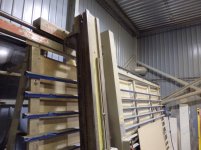I am trying to help a friend who has a vertical panel saw. Somebody before me did some adjustments and result is bent upper beam. It is just a round bar of steel around 5 meters long supported by adjustment bolts for levelling and carriage is running on two rollers.
As all of subsequent saw geometry is based on correct straightness of the beam, this has to be fixed first.
Problem is if the beam is even very little tilted in some areas, crosscut result is not 90 degrees.
I have Tesa Niveltronic electronic level, but this seems too sensitive and little imperfections on beam surface give me false interpretations (noise is killing trend).
If somebody has experience or idea please let me know.

As all of subsequent saw geometry is based on correct straightness of the beam, this has to be fixed first.
Problem is if the beam is even very little tilted in some areas, crosscut result is not 90 degrees.
I have Tesa Niveltronic electronic level, but this seems too sensitive and little imperfections on beam surface give me false interpretations (noise is killing trend).
If somebody has experience or idea please let me know.



